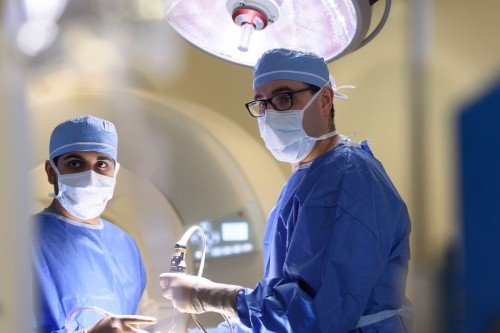Nonfunctioning tumors are the second most-common type of tumor in the pituitary gland. They occur most often in men between the ages of 50 and 60, but are found in men and women of all ages.
The majority of nonfunctioning pituitary adenomas arise in the gonadotroph cells of the pituitary gland. In extremely rare cases, adenomas in the gonadotroph cells secrete the gonadotropic hormones luteinizing hormone (LH) and follicle-stimulating hormone (FSH). These tumors, therefore, are classified as functioning adenomas instead of nonfunctioning adenomas.
Symptoms of Nonfunctioning Pituitary Adenomas
Nonfunctioning pituitary tumors are usually not diagnosed until they have grown large enough to cause symptoms. As the tumor presses on the nearby optic nerves, symptoms may include headache and vision problems.
There can be other symptoms as well if the tumor grows large enough to put pressure on the pituitary gland and block production of certain hormones. For example, men may experience loss of libido due to decreased testosterone. Women may develop irregular or absent menstrual periods.
Nonfunctioning Pituitary Adenoma Diagnosis
If your doctor suspects a nonfunctioning tumor, you may need to have an MRI scan of the brain, where the pituitary gland is located, to determine the exact size and location of the tumor.
We also perform blood tests to evaluate all levels of pituitary hormones.
Nonfunctioning Pituitary Adenoma Treatment
Surgery is the most common treatment for nonfunctioning pituitary tumors.
Memorial Sloan Kettering surgeons are experienced in using a minimally invasive approach called transsphenoidal surgery to remove pituitary tumors. The approach allows our surgeons to bypass brain tissue, operating instead through an incision inside the nasal passage. The risk for neurologic complications with this technique is very low, and the surgery leaves no visible scar.
In the rare case that the tumor is too large to be removed using transsphenoidal surgery, our surgeons may recommend a craniotomy, a procedure in which the tumor is removed through an incision made in the front of the skull.
Sometimes large tumors (macroadenomas) can be difficult to cure with surgery alone and may require additional therapy, such as radiation therapy.
Radiation Therapy for Nonfunctioning Pituitary Adenomas
Radiation therapy can be used in several ways for a nonfunctioning pituitary tumor. It may be recommended as additional therapy after surgery to prevent regrowth of the tumor. Radiation may also be used as the sole treatment if the tumor cannot be removed surgically, or if the tumor regrows after surgery.
The radiation therapy team at MSK is highly experienced in caring for people with nonfunctioning pituitary adenomas, and works closely with the other members of your care team. They have access to every form of modern radiation therapy available and will customize a treatment plan so precise that it factors in the size and shape of your tumor to the millimeter.
Their goal is to not only eliminate the tumor cells but to prevent the side effects of treatment by keeping the healthy cells around the tumor safe.
We offer several radiation therapy options for people with a nonfunctioning tumor. Learn more about our approach to radiation therapy for pituitary tumors.
Monday through Friday, to (Eastern time)



